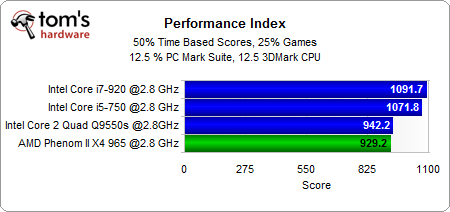Experiment: Comparing Four Quad-Core Architectures At 2.8 GHz
Conclusion
Admittedly, this shootout highlights an artificial condition. The direct comparison of various processors at a given clock speed doesn’t consider other important facts, such as market segments, platform constraints, available clock speeds, product cost, or overclocking margins. However, looking at the results of AMD and Intel processors running at the same core clock speed allows us to strictly define their differences at a set baseline.
Regular readers are aware of the situation on the processor market. Intel has the performance and the efficiency crown beyond any dispute, and this has a direct impact on processor pricing. Intel Core processors are always rather expensive. AMD has concentrated on providing maximum value based on its current portfolio, making Athlon II and Phenom II attractive options through aggressive pricing. A specific recommendation in favor or against certain options must only be given after consideration of platform aspects and total cost. Power savings on an Intel system are not worth a lot if the additional hardware cost exceeds the saved amount on the electricity bill (which it sometimes does).
As expected, Intel’s Core i7 on LGA 1366 is the undisputed performance winner at 2.8 GHz. There are a few benchmarks that run slightly better on Core i5 and LGA 1156, but these aren’t too significant in the big scheme of things. The Core 2 Quad is the direct competitor to AMD’s Phenom II X4 but it lags noticeably behind.
The efficiency battle is dominated by the Core i5 due to its 45nm fabrication process and feature cuts that do not have much impact in the real world. Core i5 lacks both the i7’s triple-channel memory controller and its Hyper-Threading, neither of which are necessary for excellent performance. Our Core 2 Quad processor also did very well, but we have to remind you that we used an S-model, which is the power efficient variant. Regular Core 2 Quad processors show significantly higher peak power.
Finally, we encourage you to take the results in stride. AMD’s Phenom II X4 isn’t as poor as the performance results at 2.8 GHz might suggest. You get faster clock speeds with AMD than on the Intel side for very little money, and once again we’d like to point at the fact that it’s the result that counts. Intel is in a comfortable position, but if AMD manages to deliver higher clock speeds and comparable performance at equal or lower cost, I’d say there is nothing wrong with that.
Get Tom's Hardware's best news and in-depth reviews, straight to your inbox.
